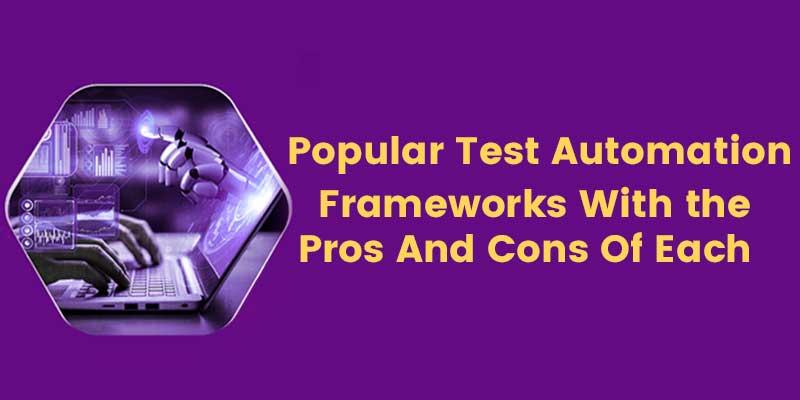Selenium is considered a prominent testing tool in the automation field among various automation frameworks. If you are interested in pursuing a career in automation, you have a wider scope of working in the top companies. Selenium Web Testing has grown to be one of the essential aspects of many organizations.
Selenium is unquestionably one of the top web testing solutions to assist developers with automation testing. The need for Selenium Web testers is thus growing and will continue to do so tremendously in the future.
If you are intended to become a selenium automation tester, you can join Selenium Training in Chennai, which will help you understand Conditions and Loops, test automation framework, Keyword List, String handling, advantages of test automation, Exception Handling, etc.
In this blog, we shall discuss the advantages of test automation and the components of the automation Testing Framework.
What is Framework?
A framework is defined as a set of predetermined norms, principles, criteria, and guidelines that can be used or followed in its entirety to take full advantage of the scaffold it offers.
For example
Elevators and lifts are utilized frequently. A few rules are listed inside the elevator that must be adhered to get the most out of the system and ensure long-term use. Now, we shall discuss how these principles help in the automation process:
Test Automation Framework
The framework developed to provide an environment in which the automation test scripts are executed known as a “Test Automation Framework.” The Framework offers the user several advantages that enable the efficient development, implementation, and monitoring of automation test scripts. It more closely resembles a system developed especially for automating our testing.
A framework is a constructive fusion of specific regulations, code quality, concepts, methods, practices, project hierarchies, modularity, reporting mechanisms, test data injections, etc., that serves as the foundation for automation testing. Thus, the user can apply these recommendations when automating applications to benefit from numerous fruitful outcomes.
The advantages can take many forms: simple to script, scalable, modular, understandable, process-definable, re-usable, affordable, and easy to maintain. Developers are therefore urged to utilize one or more of the Test Automation Framework to reap these benefits.
A single, standardized test automation framework is also required when multiple developers are working on various modules of the same application and when we wish to prevent circumstances in which each developer implements their automation method.
Advantages of test automation framework
- The developer or tester can reuse the code
- Maximum protection
- Possibility for recovery
- Inexpensive maintenance
- Low levels of manual intervention
- Simple Reporting
If you are interested in learning a python programming language, you can join Python Training in Bangalore, which is a meticulously designed course syllabus for Bangalore-based students who intend to begin their career in the development or automation field.
Types of Test Automation Framework
After gaining a fundamental understanding of an automation framework, we will introduce you to the many types of test automation frameworks available on the market.
Additionally, we would attempt to explain their advantages and disadvantages and provide practical tips. A diverse range of automation frameworks is now easily accessible.
Based on how well they support several important aspects of automation, such as reusability and simplicity of maintenance, these frameworks may be distinct from one another.
Let’s talk about a few of the most widely used test automation frameworks:
- Module-Based Testing Framework
- Library Architecture Testing Framework
- Data-Driven Testing Framework
- Keyword Driven Testing Framework
- Hybrid Testing Framework
- Behavior-Driven Development Framework
Let us discuss each of them in detail.
Module-Based Testing Framework
The foundation of the module-based testing framework is an abstraction, a well-known OOPs concept. The Framework separates the entire “Application Under Test” into various logical and independent parts. So, we can create a unique, independent test script for every module.
As a result, when several test scripts are combined, a larger test script representing different modules is generated. These modules are separated by an abstraction layer and protect this module from being affected by modifications made to the application.
Pros:
- Due to the high modularization of the Framework, the tester can automate the test efficiently.
- It is easy and cost-efficient maintenance.
- The Framework provides scalability and flexibility features.
- If the tester implements changes in any part of the applications, changes are made only to the party that will need modification, and the rest of the parts are left as it was.
Cons:
We incorporate the test data into the test scripts while independently building test scripts for every module. As a result, the test scripts need to be modified if we need to test using a different set of test data.
If you are interested in becoming a software developer, you can join Software Testing Course in Chennai, which will help you understand Software Testing techniques, types Of Testing, the Waterfall model, the V model and many other core concepts of software testing.
Library Architecture Testing Framework
The Module-Based Testing Framework is the basis and backbone of the Library Architecture Testing Framework, with feature-rich benefits. We shall separate the application into functions, or common functions that may be used by other areas of the application, instead of breaking it up into test scripts.
As a result, we create a common library of functions for the application being tested. As an outcome, if necessary, these libraries can be called from the test scripts.
The main concept behind the Framework is to identify the common processes, collect them into functions under a library, and then call those functions as needed in the test scripts.
Example: If the test scripts request the login to the application, the login, which is integrated into the function and stored in the library, will quickly gain access from the functions instead of writing a new code.
Pros:
- Like the Module-Based Framework, Library Architecture Testing Framework also has a high level of modularization, cost-efficient maintenance and scalability.
- The common function we created is efficiently used for the various test scripts for the Framework. Thus the Framework provides a high level of reusability.
Cons:
- Like the Module-Based Framework, the test data is embedded into the test scripts. Therefore, every change to the test data requires an identical modification to the test script.
- The Framework progressively becomes more complex when we add additional libraries.
Data-Driven Testing Framework
When automating or testing any application, it may occasionally be necessary to test the same functionality repeatedly with different sets of input data.
As a result, under such circumstances, we cannot allow the test data to be integrated into the test script. Therefore, it is recommended to keep test data in an external database separate from the test scripts.
The user can separate the logic of the test script from the test data with the aid of the Data-Driven Testing Framework. The user can save the test data in an external database using this tool.
Property files, XML files, Excel files, text files, CSV files, ODBC repositories, and other external databases are used. “Key-Value” pairs are typically used to store data. Thus, the data contained in the test scripts can be accessed and filled in using the key.
Pros:
The most important aspect of this Framework is that it significantly decreases the total number of scripts needed to cover all test cases. As a result, less code is required to test all possible cases.
- Any modifications to the test data matrix would not affect the test script code.
- Increases maintainability and flexibility
- By changing the test data values, a single test scenario is performed.
Cons
- The process is intricate and needs additional effort to create the test data sources and reading instructions.
- The tester can generate the test script only using the programming languages.
If you want to understand the advantages of test automation, the test automation framework, and types of the framework in selenium; you can enrol in Selenium Training in Chennai and equip yourself with the skills required to become a selenium tester.
Keyword Driven Testing Framework
The Keyword Driven Testing Framework is an addition to the Data Driven Testing Framework. It stores a specific test script code in an external data file and separates the test data from the scripts.
The Framework’s name derives from the set of codes known as Keywords. The application tasks that need to be taken are self-directed by keywords.
It is known as a “table-driven framework” since the test data and keywords are stored in a structure that resembles a table. Remember that test data and keywords are separate things that do not rely on the automation tool.
Pros:
- The great advantage of utilizing the Data-Driven testing framework is that it does not need the user to understand the programming language proficiently.
- On the other hand, Data Driven Testing requires the user to have programming language skills.
- A single keyword is used across multiple test scripts.
Cons:
- The user should understand how to create keywords effectively to obtain the advantages of the framework features.
- The feature of this framework is complex to master as it keeps updating new keywords.
If you want to become an RPA developer, you can join RPA Training in Bangalore and learn automation process techniques, the advantages of test automation, automation architecture and test automation framework for backend processes.
Hybrid Testing Framework
As its name implies, the Hybrid Testing Framework integrates more than one of the above frameworks. The best part about this configuration is that it uses all related framework benefits.
For example, if the data column includes all the data needed for the test scenario, the keyword column will have all necessary keywords utilized in the specific test case. Any step that doesn’t require input can be left unfilled.
Behavior-Driven Development Framework
Functional validations can be automated using the Behavior Driven Development framework so that Business Analysts, Developers, Testers, etc., can easily comprehend and understand. To use these frameworks, the user does not always need to be conversant with the programming language.
Components of Automation Testing Framework
- Object Repository
- Test Data
- Configuration File/Constants/ Environment Settings
- Generics/ Program logics/ Readers
- Build tools and Continuous Integration
Now that you have understood Popular Test Automation Frameworks With the Pros And Cons Of Each. To learn more about the automation frameworks, you can join Selenium Training in Bangalore, which will help you have a profound understanding of Selenium Components, Selenium & Supported Languages – Java, C# & Python, and uses of test automation framework.




